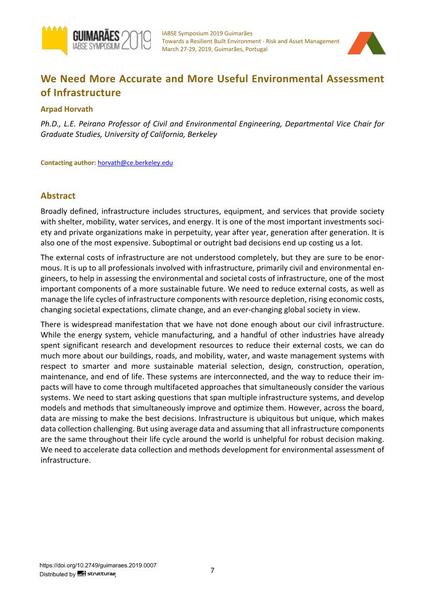We Need More Accurate and More Useful Environmental Assessment of Infrastructure

| Auteur(s): |
Arpad Horvath
(Ph.D., L.E. Peirano Professor of Civil and Environmental Engineering, Departmental Vice Chair for Graduate Studies, University of California, Berkeley)
|
|---|---|
| Médium: | papier de conférence |
| Langue(s): | anglais |
| Conférence: | IABSE Symposium: Towards a Resilient Built Environment Risk and Asset Management, Guimarães, Portugal, 27-29 March 2019 |
| Publié dans: | IABSE Symposium Guimarães 2019 |
| Page(s): | 7 |
| DOI: | 10.2749/guimaraes.2019.0007 |
| Abstrait: |
Broadly defined, infrastructure includes structures, equipment, and services that provide society with shelter, mobility, water services, and energy. It is one of the most important investments soci- ety and private organizations make in perpetuity, year after year, generation after generation. It is also one of the most expensive. Suboptimal or outright bad decisions end up costing us a lot. The external costs of infrastructure are not understood completely, but they are sure to be enor- mous. It is up to all professionals involved with infrastructure, primarily civil and environmental en- gineers, to help in assessing the environmental and societal costs of infrastructure, one of the most important components of a more sustainable future. We need to reduce external costs, as well as manage the life cycles of infrastructure components with resource depletion, rising economic costs, changing societal expectations, climate change, and an ever-changing global society in view. There is widespread manifestation that we have not done enough about our civil infrastructure. While the energy system, vehicle manufacturing, and a handful of other industries have already spent significant research and development resources to reduce their external costs, we can do much more about our buildings, roads, and mobility, water, and waste management systems with respect to smarter and more sustainable material selection, design, construction, operation, maintenance, and end of life. These systems are interconnected, and the way to reduce their im- pacts will have to come through multifaceted approaches that simultaneously consider the various systems. We need to start asking questions that span multiple infrastructure systems, and develop models and methods that simultaneously improve and optimize them. However, across the board, data are missing to make the best decisions. Infrastructure is ubiquitous but unique, which makes data collection challenging. But using average data and assuming that all infrastructure components are the same throughout their life cycle around the world is unhelpful for robust decision making. We need to accelerate data collection and methods development for environmental assessment of infrastructure. |
0.15 MB
- Informations
sur cette fiche - Reference-ID
10563056 - Publié(e) le:
14.02.2021 - Modifié(e) le:
21.05.2021



